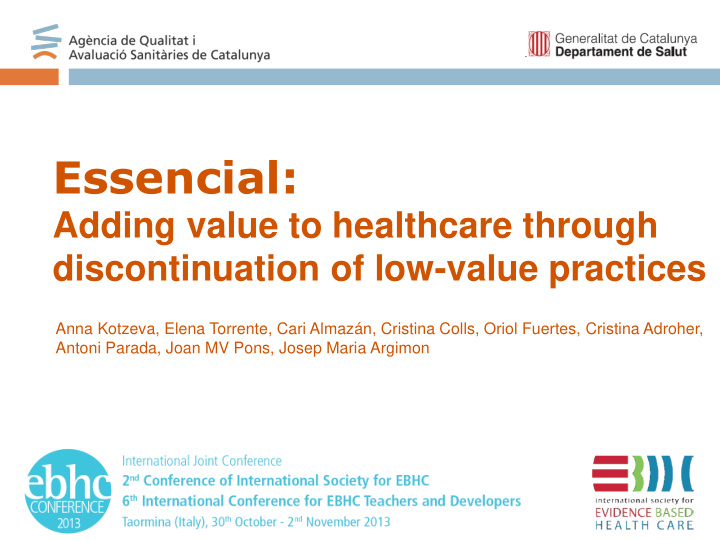



Essencial: Adding value to healthcare through discontinuation of low-value practices Anna Kotzeva, Elena Torrente, Cari Almazán, Cristina Colls, Oriol Fuertes, Cristina Adroher, Antoni Parada, Joan MV Pons, Josep Maria Argimon
Background Scientific community (overdiagnosis / overtreatment alerts) Healthcare Systems (economic constraints) NEED FOR: 1) Revision of routine clinical practices 2) Revision of health coverage lists 3) Patient empowerment and shared DM Patients & Citizens (proactive and informed)
Background Different strategies towards reducing waste in healthcare: “do not do” recommendations* (NICE, UK) ( source: CPGs ) Choosing Wisely**(ABIM Foundation&Consumer reports,USA) (source: medical specialty societies ) Quality framework of the Australian Government*** (source: published evidence + key informants ) …. * Garner S, Littlejohns P. Disinvestment from low value clinical interventions: NICEly done? BMJ 2011; 343: d4519. ** Cassel CK, Guest JA. Choosing wisely: helping physicians and patients make smart decisions about their care. JAMA 2012; 307: 1801-1802. *** Medical Benefits Reviews Task Group. Development of a quality framework for the Medicare Benefits Schedule. Discussion paper. Canberra: Australian Government Department of Health and Ageing, 2010.
March 2013: in Catalonia is launched the ESSENCIAL Project
Aims 1. To identify low-value practices and promote their discontinuation through implementation of specific recommendations for the clinical practice 2. To encourage healthcare professionals’ involvement in the identification and in the process of change management within the system. 3. To foster general culture of overuse-, misuse- and waste- avoidance in healthcare, and to enhance patient understanding and knowledge of these processes VISION: ESSENCIAL Project contributes to care quality improvement and sustainable allocation of healthcare resources in Catalonia
Methods The process is explicit and transparent, comprising 4 phases: 1 2 3 4 Prioritization Identification of Dissemination and Impact low value and assessment elaboration of implementation practices recommendations Participation of health professionals and scientific community
Identification and prioritization Low-value practices Information sources ineffective or lack evidence on scientific evidence (CPGs, SRs, their effectiveness HTA reports) negative risk-benefit balance other published low-value lists more cost-effective alternatives nominations from clinical and non- exists clinical stakeholder groups knowledgeable of the context and obsolete due to the introduction the local health system performance of new technologies Context-based prioritization (local healthcare system data and policies) Elaboration of recommendations to the clinical practice
Multichannel communication strategy Website Scientific Social events networks Consumers Clinical Regional specialty meetings societies
Implementation and impact assessment Implementation activities are based on Opinion Dissemination Change Management model and include: leaders *tailored communication strategies, *training, *clinical decision support systems, *provider- Incentives and Training and specific performance measures. processes skills Impact assessment applies quantitative and qualitative methodologies Involves three main areas: degree of awareness of the recommendations among target health professionals (surveys) direct impact on clinical practice, measured by the change in use rates of practices recommended as of “low - value” (database assessment) budgetary impact attributable to the adoption of the recommendations
Results at 7 months 17 recommendations Imaging for low-back pain, Pre-operatory Rx in asymptomatic patients, Duration of post- ictus rehabilitation, Imaging for simple headache, Bisphosphonates in post-menopausic women with low fracture risk, Overuse use of proton pump inhibitors, Routine screening for breast cancer, PSA for prostate cancer screening, Cough-and-cold medications in children, Routine episiotomy, Urinary catheter in patients with stroke, Antibiotics in otitis media, Hospitalization for community-acquired pneumonia
Results at 7 months 17 recommendations Oncology: 2 Screening: 3 Radiology: 7 Primary care: 12 Reumatology:2 Diagnosis: 3 Pediatrics: 2 Hospital care: 4 Treatment: 6 Cardiology: 3 Gynecology: 1 Rehabilitation: 1 Nursing: 1 Prevention: 2 Neurology: 2 Surgery: 1 Follow-up: 1 Public Health:3 Rehabilitation:1 Pneumology:1 Urology: 1
Reaching key stakeholders channel impact 15.000 visits http://essencialsalut.gencat.cat 7 regional authorities Presentations and meeting 18 clinical specialty societies with key stakeholders 15 healthcare providers 900 healthcare professionals email 2.800 persons receive the newsletter 8 videos of opinion leaders 63 tweets #essencialsalut and retweets reaching 10.000 users 1 st impact assessment planned: March 2014
Limitations Such type of initiatives need to provide timely information, but are very time- and resource-consuming. The implementation process is conditioned by a range of context-related (current payment system, professional incentives, etc) and professional-related (culture and mindset, predisposition towards change) factors which, not always are identified at the initial stage as barriers to recommendation uptake.
Conclusions/Lessons learned so far… Multiple sources for identification of low-value practices and good knowledge of the context are needed to ensure the relevance of promoted recommendations. Total discontinuation is rarely recommended and an accurate definition of the conditions in which the practice is considered as “low - value” needs to be elaborated . The success of the implementation could be improved by a priori investigation of the potential barriers and facilitators and by a broad stakeholder commitment for collaboration. Clear priorities, detailed planning and early involvement of target professionals are key to continuity and success of such type of initiatives.
Thank you! akotzeva@gencat.cat http://essencialsalut.gencat.cat
More recommend